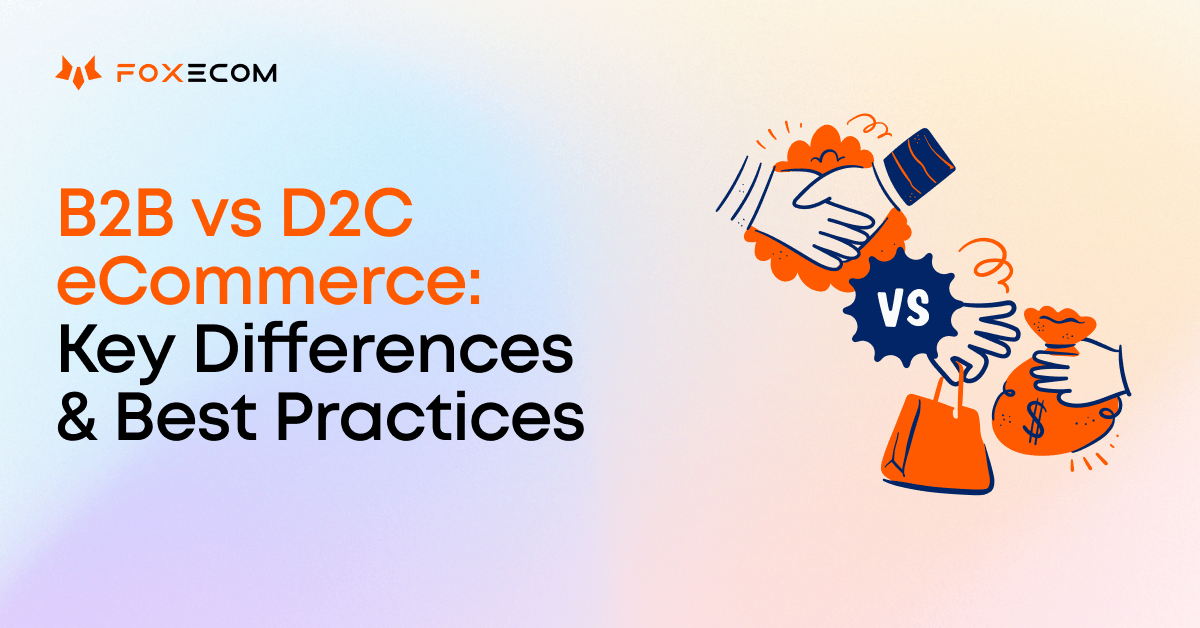Checking out the Prospective of D2C Ecommerce: A Comprehensive Guide for Companies
The D2C ecommerce design presents a substantial shift in just how brands engage with consumers. It enables firms to bypass conventional retail networks, promoting deeper connections and possibly enhanced profit margins. This approach is not without its complexities. Comprehending the nuances of D2C ecommerce is vital for brand names aiming to prosper. What strategies can they adopt to navigate this evolving landscape successfully? The responses may redefine their business approaches.
Comprehending the D2C Ecommerce Version

Key Advantages of D2C Ecommerce for Brands
The D2C ecommerce model provides brands significant advantages, especially concerning enhanced earnings margins. By eliminating intermediaries, companies can maintain a larger share of sales income. In addition, this straight connection with clients cultivates enhanced brand name commitment, encouraging repeat acquisitions and lasting involvement.
Raised Earnings Margins

Improved Brand Commitment
Structure on the financial benefits of D2C ecommerce, enhanced brand name loyalty becomes one more essential advantage for firms engaging straight with consumers. By developing a direct connection, brands can foster much deeper partnerships with their customers, acquiring insights right into habits and choices. This straight communication permits for even more tailored advertising and marketing strategies, which resonate strongly with consumers. Furthermore, brand names have the chance to regulate their messaging and customer experience, enhancing brand values and developing trust. When consumers feel an individual connection, they are much more likely to return, advocate for the brand, and take part in community involvement. Ultimately, boosted brand name commitment not only drives repeat purchases but additionally grows an enthusiastic customer base, additional strengthening a brand's setting in the marketplace.
Challenges Dealt With by D2C Brands
D2C brand names come across numerous significant difficulties that can influence their success. Supply management issues can result in equip scarcities or excess, complicating operations and consumer fulfillment. Additionally, marketing budget restrictions usually restrict the ability to effectively get to and involve target market.
Supply Administration Issues
Reliable inventory management provides an awesome difficulty for many brand names running in the direct-to-consumer (D2C) space. These brands often grapple with fluctuating demand, which can bring about overstock or stockouts, inevitably influencing client contentment and income. In addition, the absence of innovative stock radar can cause disparities in between real supply levels and reported information, complicating order satisfaction. The diverse variety of items D2C brand names commonly use also makes complex stock management, as variants in dimensions, designs, and colors require even more careful oversight. Moreover, several D2C businesses might deal with limited warehousing abilities, resulting in inefficient use space and sources. Subsequently, reliable stock administration stays a vital hurdle for D2C brands going for lasting development and functional performance.
Advertising Spending Plan Constraints
Steering marketing budget plan restraints is a considerable obstacle for several direct-to-consumer (D2C) brands. Limited funds often limit these business' capability to buy comprehensive advertising and marketing strategies, resulting in decreased presence in an open market. D2C brands regularly come to grips with the requirement to make the most of roi (ROI) while targeting specific audiences efficiently. This challenge is intensified by rising prices in electronic advertising and marketing and the requirement to allocate funds throughout multiple channels, including social networks, internet search engine, and e-mail advertising and marketing. Lots of D2C brand names should introduce economical advertising remedies, leveraging natural growth techniques and influencer collaborations. Eventually, successfully navigating these budget plan restrictions is vital for maintaining development and achieving long-term earnings in the developing ecommerce landscape.
Approaches for Building an Effective D2C Ecommerce Business
As customers increasingly look for straight connections with brands, establishing an effective D2C ecommerce service requires a tactical approach that focuses on client involvement and depend on. One efficient technique is to develop engaging brand name narratives that reverberate with target audiences, fostering emotional connections. Making use of social networks platforms can boost visibility and assist in two-way interaction, allowing brands to engage directly with customers.Moreover, customized experiences through customized advertising and marketing initiatives can substantially boost customer retention and loyalty. Applying commitment programs and supplying special offers can even more incentivize repeat purchases.Streamlining the buying procedure is vital, guaranteeing an easy to use interface that improves the purchasing experience. In addition, clear interaction relating to delivery and returns builds trust fund and encourages consumer confidence.Finally, proactively looking for customer comments and replying to it shows a dedication to enhancement and customer contentment, vital aspects in the competitive D2C landscape.
Leveraging Modern Technology for Improved Consumer Experience
In today's affordable D2C ecommerce landscape, modern technology plays a crucial function fit customer experiences. Companies progressively make use of advanced tools such as fabricated knowledge, chatbots, and individualized algorithms to improve interactions and simplify the shopping process. By integrating these technologies, brand names can offer customized item recommendations based on specific preferences and purchasing behaviors, promoting an extra interesting experience.Moreover, responsive internet site layouts and mobile applications ensure that customers can access services perfectly throughout various devices. Improved settlement remedies, including one-click check outs and digital wallets, additionally simplify purchases, making it simpler for consumers to make purchases.Data analytics additionally enables services to collect insights into customer actions, enabling continuous improvement of solutions and offerings. In general, leveraging innovation not that site only enhances client complete satisfaction however additionally cultivates commitment, ultimately driving lasting success in the D2C ecommerce market.
Advertising And Marketing Tips to Drive D2C Sales
Just how can brands successfully catch the attention of customers in a saturated market? To grow in the direct-to-consumer (D2C) landscape, brand names should utilize targeted marketing techniques. Using social networks systems, brand names can engage consumers via interactive content, influencer partnerships, and user-generated messages. Personalized e-mail campaigns can additionally foster a you could try these out feeling of link, using tailored promotions based on consumer habits and preferences.Moreover, narration plays an essential role in distinguishing a brand's story, making it unforgettable and relatable. Brands need to purchase search engine optimization (SEARCH ENGINE OPTIMIZATION) to improve exposure, guaranteeing their items are quickly visible online. In addition, leveraging information analytics enables businesses to fine-tune their marketing strategies and understand consumer patterns better. Ultimately, a multi-channel technique that incorporates creative thinking with data-driven insights can significantly enhance D2C sales, permitting brand names to stick out in a crowded industry.
Future Patterns in D2C Ecommerce
With the rapid advancement of modern technology and customer choices, the future of D2C ecommerce is positioned for considerable change. Arising fads show a shift in the direction of hyper-personalization, where brands take advantage of data analytics to tailor offerings to individual consumer needs. This modification boosts customer experiences, fostering commitment and engagement.Moreover, sustainability is coming to be an essential factor, with customers progressively preferring brands that prioritize eco-friendly practices - D2C Ecommerce Agency. Business are expected to adopt transparent supply chains and sustainable materials to fulfill this demand.The combination of synthetic knowledge and boosted fact will furthermore transform the purchasing experience, permitting consumers to envision items in their atmospheres prior to acquisition. On top of that, social business is anticipated to expand, as platforms like Instagram and TikTok promote seamless buying experiences straight within social media.These fads jointly signify a vibrant future for D2C ecommerce, emphasizing customer-centric strategies and innovative technologies that redefine customer interactions
Regularly Asked Concerns
What Industries Benefit The Majority Of From D2C Ecommerce?
The current concern highlights markets that grow through direct-to-consumer (D2C) ecommerce. Incredibly, fashion, elegance, electronic devices, and food markets take advantage of D2C designs to enhance brand name commitment, boost client partnerships, and optimize profit margins effectively.
How Do Shipping Expenses Affect D2C Pricing Strategies?
Shipping expenses substantially affect D2C rates strategies. Organizations have to stabilize these costs with affordable prices, taking into consideration consumer expectations and revenue margins. Reliable monitoring of shipping can improve customer satisfaction and drive sales in direct-to-consumer designs.
What Payment Choices Should D2C Services Deal?
D2C businesses must supply varied settlement choices, consisting of credit/debit cards, digital purses, and get now, pay later on solutions. This variety improves customer comfort, boosts conversion prices, and deals with various customer choices in the on-line shopping landscape.
Exactly How Can D2C Brands Manage Client Returns Properly?
D2C brand names can take care of consumer returns efficiently by executing user-friendly return policies, providing prepaid delivery tags, and making sure prompt refunds (D2C Ecommerce Agency). Clear communication and structured processes site web improve consumer fulfillment and encourage repeat organization
What Lawful Considerations Exist for D2C Ecommerce Procedures?
Lawful considerations for D2C ecommerce operations include conformity with consumer defense regulations, information privacy guidelines, intellectual residential property civil liberties, and taxes requirements. Brands must browse these complexities to prevent lawful risks and assure smooth operations. By removing intermediaries, D2C brand names can supply affordable prices and cultivate a much more intimate relationship with their customers.The D2C design is defined by its reliance on digital systems, making it possible for brand names to use social media, online industries, and their own internet sites to involve with customers straight. D2C ecommerce assists in the collection of important consumer data, enabling brand names to customize their offerings and advertising techniques effectively, eventually driving sales and enhancing margins. Furthermore, brands have the chance to control their messaging and customer experience, enhancing brand name values and building depend on. As customers significantly seek straight links with brands, developing a successful D2C ecommerce business calls for a tactical strategy that focuses on client engagement and trust fund. D2C brand names can manage client returns successfully by implementing user-friendly return plans, providing pre-paid delivery tags, and guaranteeing timely refunds.
Comments on “How a D2C Ecommerce Agency Future-Proofs Your Business Against Retail Disruption”